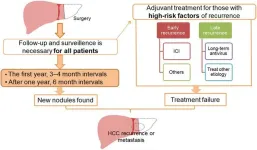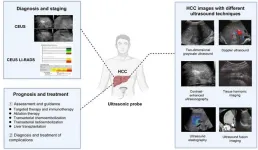(Press-News.org) As part of a nationwide trend, many more of NYU Langone Health’s patients during the pandemic started using electronic health record tools to ask their doctors questions, refill prescriptions, and review test results. Many patients’ digital inquiries arrived via a communications tool called In Basket, which is built into NYU Langone’s electronic health record (EHR) system, EPIC.
While physicians have always dedicated time to managing EHR messages, they saw a more than 30% annual increase in recent years in the number of messages received daily, according an article by Paul A. Testa, MD chief medical information officer at NYU Langone. Testa wrote that it is not uncommon for physicians to receive more than 150 In Basket messages per day. With health systems not designed to handle this kind of traffic, physicians ended up filling the gap, spending long hours after work sifting through messages. This burden is cited as a reason that half of physicians report burnout.
Now a new study, led by researchers at NYU Grossman School of Medicine, shows that an AI tool can draft responses to patients’ EHR queries as accurately as their human healthcare professionals, and with greater perceived “empathy.” The findings highlight these tools’ potential to dramatically reduce physicians’ In Basket burden while improving their communication with patients, as long as human providers review AI drafts before they are sent.
NYU Langone Health has been testing the capabilities of generative artificial intelligence (genAI), in which computer algorithms develop likely options for the next word in any sentence based on how people have used words in context on the internet. A result of this next-word prediction is that genAI “chatbots” can reply to questions in convincing human-like language. NYU Langone in 2023 licensed “a private instance” of GPT4, the latest relative of the famous chatGPT chatbot, which let physicians experiment using real patient data while still adhering to data privacy rules.
Published online July 16 in JAMA Network Open, the new study examined GPT4-generated drafts to patient In Basket queries, and had primary care physicians compare them to the actual human responses to those messages.
“Our results suggest that chatbots could reduce the workload of care providers by enabling efficient and empathetic responses to patients’ concerns,” said lead study author William Small, MD, a clinical assistant professor in Department of Medicine at NYU Grossman School of Medicine. “We found that EHR-integrated AI chatbots that use patient-specific data can draft messages similar in quality to human providers.”
For the study, sixteen primary care physicians rated 344 randomly assigned pairs of AI and human responses to patient messages on accuracy, relevance, completeness, and tone, and indicated if they would use the AI response as a first draft, or have to start from scratch in writing the patient message. The physicians did not know whether the responses they were reviewing were generated by humans or the AI tool (blinded study).
The research team found that the accuracy, completeness, and relevance of generative AI and human providers responses did not differ statistically. Generative AI responses outperformed human providers in terms of understandability and tone by 9.5%. Further, the AI responses were more than twice as likely (125 percent more likely) to be considered empathetic and 62% more likely to use language that conveyed positivity (potentially related to hopefulness) and affiliation (“we are in this together”).
On the other hand, AI responses were also 38% longer and 31% more likely to use complex language, so further training of the tool is needed, the researchers say. While humans responded to patient queries at a 6th grade level, AI was writing at an 8th grade level, according to a standard measure of readability called the Flesch Kincaid score.
The researchers argued that use of private patient information by chatbots, rather than general internet information, better approximates how this technology would be used in the real world. Future studies will be needed to confirm whether private data specifically improved AI tool performance.
“This work demonstrates that the AI tool can build high-quality draft responses to patient requests,“ said corresponding author Devin Mann, MD, senior director of Informatics Innovation in NYU Langone Medical Center Information Technology (MCIT). “With this physician approval in place, GenAI message quality will be equal in the near future in quality, communication style, and usability, to responses generated by humans,” added Mann, also a professor in the Departments of Population Health and Medicine.
Along with Drs. Small and Mann, study authors from NYU Langone Health were Beatrix Brandfield-Harvey, Zoe Jonassen, Soumik Mandal, Elizabeth Stevens, Vincent Major, Erin Lostraglio, Adam Szerencsy, Simon Jones, Yindalon Aphinyanaphongs, and Stephen Johnson. Also authors were Oded Nov in the NYU Tandon School of Engineering, and Batia Wiesenfeld of NYU Stern School of Business.
The study was funded by National Science Foundation grants 1928614 and 2129076) and Swiss National Science Foundation grants P500PS_202955 and P5R5PS_217714.
END
AI tool successfully responds to patient questions in electronic health record
2024-07-16
ELSE PRESS RELEASES FROM THIS DATE:
New analysis of Cassini data yields insights into Titan’s seas
2024-07-16
UNDER EMBARGO UNTIL JULY 16, 2024, AT 11:00 AM ET
ITHACA, N.Y. – A new study of radar experiment data from the Cassini-Huygens mission to Saturn has yielded fresh insights related to the makeup and activity of the liquid hydrocarbon seas near the north pole of Titan, the largest of Saturn’s 146 known moons.
The key takeaway: Using data from several bistatic radar experiments, a Cornell University-led research team was able to separately analyze and estimate the composition and roughness of Titan’s sea surfaces, something previous analyses of monostatic radar data were unable to achieve. This will help pave the way for future combined ...
New sleep study aims to understand cognitive decline in women
2024-07-16
LA JOLLA, CA—Alzheimer’s disease, the most common type of dementia, currently affects twice as many women as men, with minority populations predicted to witness the most significant increase in cases in the coming years, according to the Centers for Disease Control and Prevention.
Disturbances in sleep are well-known in dementia but have previously been explained as an outcome of the disease, not the cause. Increasing evidence, however, now implicates sleep disturbances with the development of dementia.
In a bid to better understand the relationship between sleep and cognitive outcomes in women, scientists at the Scripps ...
Turning agricultural trash to treasure
2024-07-16
In California's Northern San Joaquin Valley, agricultural leftovers such as almond shells, fruit peels, and orchard trimmings can potentially be converted into sustainable bioproducts and biofuels – with the right technology. Today, Schmidt Sciences’ Virtual Institute on Feedstocks of the Future awarded new funding to a group investigating how to make better use of the diverse agricultural waste in the region.
The group, “Building the Circular Bioeconomy in the North San Joaquin Valley” or BioCircular Valley, is co-led by the Department of Energy’s Lawrence Berkeley National Laboratory (Berkeley Lab), UC Berkeley, and BEAM Circular, ...
Adjuvant therapy for hepatocellular carcinoma after curative treatment: Several unanswered questions
2024-07-16
Hepatocellular carcinoma (HCC) is one of the most prevalent malignancies globally and is the third leading cause of cancer-related deaths. The primary curative treatments for HCC are liver transplantation, hepatectomy, and local ablation. However, the recurrence rate of HCC following hepatectomy or ablation remains alarmingly high, up to 70%, severely impacting patient prognosis and overall survival (OS). To mitigate postoperative recurrence and improve patient outcomes, various adjuvant therapies have been explored. Despite the efficacy of several adjuvant treatments in reducing recurrence rates and enhancing survival, ...
Palliative care is underutilized in nursing homes
2024-07-16
INDIANAPOLIS – Palliative care, specialized medical care focusing on providing relief from the symptoms -- including pain -- and the stress of serious illness, is underutilized in nursing homes, despite the large number of nursing home residents living with a serious illness such as cancer, dementia, Parkinson’s disease, heart failure or chronic obstructive pulmonary disease.
A qualitative study, published in the Journal of the American Geriatrics Society, analyzes lack of palliative ...
Understanding others: By age three, we can do this with mirror neurons
2024-07-16
Milan, July 15, 2024 – By the age of three, children are capable of understanding others, "mirroring" those they are with to imitate and anticipate their intentions. They are able to do it thanks to the sophisticated neurofunctional architecture that is necessary to understand others' intentions, the mirror neurons, that result already active at this age.
It’s the result of a study published in the prestigious journal PNAS, led by the collaboration between Giacomo Rizzolatti of the University of ...
Oil and natural gas development in Permian is a key source of ozone pollution in Carlsbad Caverns National Park
2024-07-16
EMBARGO: THIS CONTENT IS UNDER EMBARGO UNTIL 9 A.M. U.S. EASTERN STANDARD TIME ON JULY 16. INTERESTED MEDIA MAY RECIVE A PREVIEW COPY OF THE JOURNAL ARTICLE IN ADVANCE OF THAT DATE OR CONDUCT INTERVIEWS, BUT THE INFORMATION MAY NOT BE PUBLISHED, BROADCAST, OR POSTED ONLINE UNTIL AFTER THE RELEASE WINDOW.
New research shows that ozone concentrations at Carlsbad Caverns National Park frequently exceed Environmental Protection Agency health standards, likely due to oil and natural gas development in the Permian Basin and surrounding region.
The work was led through the Department of Atmospheric Science at Colorado State University and is part of ...
E. coli variant may cause antimicrobial resistance in dogs, humans
2024-07-16
ITHACA, N.Y. – Researchers studying antimicrobial-resistant E. coli – the leading cause of human death due to antimicrobial resistance worldwide – have identified a mechanism in dogs that may render multiple antibiotic classes ineffective.
The paper, which will publish July 16 in the journal Applied and Environmental Microbiology at 9:00am EST, opens up new avenues for therapies to treat both animals and humans – and establishes clinical infections in dogs as a surveillance approach for public health.
The research team analyzed more than 1,000 genomes of the resistant ...
Ultrasonography of hepatocellular carcinoma: From diagnosis to prognosis
2024-07-16
Hepatocellular carcinoma (HCC) is a primary malignancy of the liver and one of the leading causes of cancer-related deaths worldwide. Early detection and accurate diagnosis are crucial for effective management and improved survival rates. Ultrasound (US) technology has significantly advanced and plays a pivotal role in the surveillance, diagnosis, and treatment of HCC. This paper delves into various ultrasound techniques and their clinical applications in HCC management.
Two-dimensional gray-scale ultrasound is a fundamental imaging technique for HCC surveillance. ...
Partisan politics and perceptions of immorality
2024-07-16
Democrats and Republicans overestimate the percentage of people in the opposing party who approve of widely agreed-upon moral wrongs, such as theft or animal abuse, according to a study. Today, Americans hate their opposing political party more than they love their own party, and political animosity and dehumanization of opposing party members have been on the rise for decades. Curtis Puryear and colleagues looked for a “basic morality bias” in social media posts from 5,806 political partisans by searching for words that referencd ...



